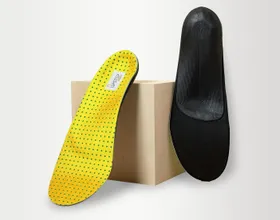Why a Quick Switch to Barefoot Shoes Can Make Plantar Fasciitis Worse
You have plantar fasciitis because your foot tissue is already damaged and needs support to heal. Barefoot shoes remove that support and force your injured plantar fascia to absorb all impact, making your heel pain worse instead of better.
Updated December 2, 2025

Wondering if barefoot shoes help plantar fasciitis? It's a fair question. With so many success stories and natural health advocates promoting minimalist footwear, you'd expect them to be beneficial.
The marketing promises sound too good to ignore: "natural movement," "stronger feet," "the way humans were meant to walk." Maybe this is the answer to your heel pain.
It's not.
If you have plantar fasciitis, switching to barefoot shoes will make your condition worse. Here's why that happens and what you should do instead.
» Learn to recognize the signs that your plantar fasciitis is healing
What Happens in Plantar Fasciitis?
When you have plantar fasciitis, your foot has already failed. The condition isn't just inflammation, despite the "-itis" suffix. It's structural degeneration of the plantar fascia tissue [1].
Your foot shape, muscle weakness, or mobility restrictions have created a perfect storm. Maybe you have flat feet that overstretch the fascia. Maybe you have high arches that make your foot too rigid to absorb impact.
Maybe weak foot muscles have forced your plantar fascia to work overtime maintaining your arch. External factors compound these problems. Poor footwear, hard surfaces, and sudden activity increases all add stress to an already vulnerable structure.
The result? Your plantar fascia develops micro-tears and degenerates [1]. Each step stretches damaged tissue. Your body compensates by changing how you walk, which creates new problems throughout your kinetic chain.
» Find out if you should wear barefoot shoes for flat feet
What Makes Minimalist Shoes Appealing for Plantar Fasciitis?
Barefoot shoes promise to fix foot problems by mimicking natural, unshod walking. They feature thin soles, zero heel-to-toe drop, wide toe boxes, and no arch support. The idea is simple: modern shoes have weakened our feet, so removing that support will strengthen them.
This logic seems sound. Our ancestors walked barefoot for thousands of years without foot pain. Why shouldn't we?
The problem is that you already have plantar fasciitis. Your plantar fascia (the thick band of tissue connecting your heel to your toes) is damaged. Expecting it to heal while removing all support is like asking a broken bone to mend while you keep using it normally.
7 Reasons Why Minimalist Shoes Aren't Good For Plantar Fasciitis
While minimalist footwear works for some foot conditions, plantar fasciitis presents unique challenges that make barefoot shoes counterproductive:
1. Zero Cushioning Removes Shock Absorption When Needed Most
Traditional shoes provide passive shock absorption through cushioned soles and arch support. Barefoot shoes remove both, forcing your damaged plantar fascia to absorb all the impact.
Research shows that 82% of people wearing shoes with minimal arch support develop plantar fasciitis [2]. The study found direct links between reduced cushioning, zero heel-to-toe drop, and increased heel pain.
Your plantar fascia wasn't designed to be your foot's primary shock absorber. When it's already damaged, asking it to take on this role accelerates the degeneration.
» Discover obvious signs that you need arch support
2. Standing Jobs Force Your Fascia to Work Overtime
If you work in an office or retail job, prolonged standing in barefoot shoes will worsen your symptoms. The lack of arch support means your plantar fascia must maintain your arch height for hours.
Healthy feet might adapt to this demand over time. Your damaged plantar fascia can't. The continuous tension irritates the already-inflamed tissue and perpetuates the pain cycle.
3. Walking Creates Higher Pressure Without Supportive Shoes
A sudden switch from supportive shoes to barefoot shoes creates higher plantar pressures during walking. Research confirms that minimalist footwear increases strain on the plantar fascia compared to traditional shoes [3].
Your foot hasn't had time to adapt. The muscles that should provide active stability are weak from years of passive support. The transition period requires months of gradual adaptation, time your damaged plantar fascia doesn't have.
» Find out if there's such thing as too much support for plantar fasciitis
4. Running Loads Exceed Your Damaged Fascia's Capacity
Running loads are significantly higher than walking loads. When you run in barefoot shoes with plantar fasciitis, you're asking damaged tissue to absorb forces it can't handle.
The plantar fascia must maintain arch height while absorbing impact. Without built-in support, micro-tears worsen. Pain increases. The condition progresses instead of healing.
5. Hard Surfaces Send Shock Through Unprotected Feet
Modern life happens on concrete, tile, and asphalt. These hard surfaces increase ground reaction forces that travel up through your foot.
Barefoot shoes provide no buffer between these forces and your damaged plantar fascia. The shock translates directly through your foot, worsening inflammation and pain.
» Explore the common causes of heel pain after running
6. Sports Create Massive Loads That Worsen Micro-tears
Sports and high-impact activities create the worst scenario for plantar fasciitis sufferers in barefoot shoes.
The combination of sudden direction changes, jumping, and landing creates massive loads through your plantar fascia.
Without cushioning and arch support, these activities can create new micro-tears or worsen existing damage. The plantar fascia simply cannot absorb these loads while healing.
7. Heavy Bodies and High Steps Overload Unsupported Fascia
Heavier individuals place more load on their plantar fascia with each step. Barefoot shoes remove the support systems that help distribute this load.
High daily step counts create continuous, smaller loads that add up over time. Without proper support, this repetitive stress prevents healing and can worsen the condition.
People with high step counts who switch to barefoot shoes often report increased pain and longer recovery times.
» Read our in-depth plantar fasciitis treatment guide
Gradual Transitions Fail Because Damage Needs Healing
Supporters of barefoot shoes acknowledge the need for gradual transitions. They recommend slowly increasing wear time over weeks or months.
This approach might work for healthy feet. But you don't have healthy feet. You have damaged plantar fascia that needs support to heal, not additional stress to "toughen up."
The gradual transition strategy assumes your foot will adapt and strengthen. Research shows that people with existing plantar fasciitis who attempt this transition often experience worsened symptoms, not improvement [3].
Switching Shoe Types Creates Inconsistent Loading Patterns
Some people try alternating between barefoot shoes and supportive footwear. The theory is that this provides the "best of both worlds," strengthening during barefoot periods and support during recovery periods.
This approach creates inconsistent loading patterns that confuse your healing tissues. Your foot never fully adapts to either shoe type. The constant changes in support and loading can actually delay healing.
» Find out why zero drop shoes are bad for your feet
When Might Barefoot Shoes Be Appropriate?
- After Complete Healing: Once plantar fasciitis has fully resolved and you've addressed underlying causes, a gradual transition to minimalist footwear might be possible.
- For Prevention in Healthy Feet: People without current foot pain may benefit from strengthening exercises and gradual barefoot shoe introduction. But not during active symptoms: The research is clear that removing support from already-damaged tissue delays healing.
What Actually Works for Plantar Fasciitis
Custom orthotics provide the support your damaged plantar fascia needs while it heals. Research shows that custom orthotics improve first-step pain and reduce plantar fascial thickness over 12 weeks [4].
Quality insoles like Upstep's Plantar Fasciitis Orthotics are engineered to your specific foot shape and condition. They provide arch support that reduces strain on your plantar fascia. The cushioning absorbs impact that would otherwise stress damaged tissue.
Custom orthotics work in any shoe, including athletic footwear designed for your activities. They're durable, adjustable, and designed for long-term use.
The key is addressing the underlying factors that caused your plantar fasciitis while providing the support your foot needs to heal. This includes strengthening weak muscles, improving mobility restrictions, and modifying activities that worsen symptoms.
» Read our in-depth review of custom orthotics for plantar fasciitis
Damaged Tissue Needs Support, Not Stress
Barefoot shoes worsen plantar fasciitis because they remove support from tissue that's already damaged. The "natural" approach ignores the fact that your foot has already failed to function naturally.
Barefoot shoes might have a place in your future after your plantar fasciitis heals completely. But right now, they're the wrong choice for your damaged plantar fascia.
Custom orthotics from Upstep offer the targeted support your foot needs to heal properly while maintaining the activity level you want. They're designed specifically for your foot shape, your activities, and your condition, not for some idealized version of how feet "should" work.
Your plantar fasciitis developed because multiple factors overwhelmed your foot's ability to function. The solution isn't removing more support. It's providing the right support while addressing those underlying factors.
That's how you get back to pain-free mornings and the activities you love.
References:
- B. K. Buchanan, R. E. Sina, and D. Kushner, “Plantar fasciitis,” StatPearls - NCBI Bookshelf, Jan. 07, 2024. Available: https://www.ncbi.nlm.nih.gov/books/NBK431073/
- K. B. Landorf, M. R. Kaminski, S. E. Munteanu, G. V. Zammit, and H. B. Menz, “Activity and footwear characteristics in people with and without plantar heel pain: A matched cross‐sectional observational study,” Musculoskeletal Care, vol. 21, no. 1, pp. 35–44, Jun. 2022, doi: 10.1002/msc.1663. Available: https://pubmed.ncbi.nlm.nih.gov/35678543/
- M. Izquierdo-Renau, “Effects of Minimalist Footwear and Foot Strike Pattern on Plantar Pressure during a Prolonged Running,” Journal of Applied Sciences, Available: https://www.mdpi.com/2076-3417/12/1/506
- C. Bishop, D. Thewlis, and S. Hillier, “Custom foot orthoses improve first-step pain in individuals with unilateral plantar fasciopathy: a pragmatic randomised controlled trial,” BMC Musculoskeletal Disorders, vol. 19, no. 1, Jul. 2018, doi: 10.1186/s12891-018-2131-6. Available: https://doi.org/10.1186/s12891-018-2131-6
Disclaimer: The information on this blog is for educational purposes only and is not a substitute for professional medical advice. Upstep does not provide medical diagnosis or treatment. While qualified podiatrists create our content, it's essential to consult with your healthcare provider for any foot or ankle concerns you may have.
FAQs
Who should avoid barefoot shoes?
People with severe foot pain, weak arches, diabetes-related neuropathy, or unresolved injuries should avoid them without medical guidance.
What are the negatives of barefoot shoes?
They offer little cushioning or support, can increase injury risk if you transition too quickly, and may not suit all terrains.
What can a physio do for plantar fasciitis?
They provide exercises to stretch and strengthen the foot and calf, manual therapy, taping, gait analysis, and advice on footwear or orthotics.
Is plantar fasciitis a disability?
Plantar fasciitis is not usually classified as a disability. Most people recover with treatment like stretching, physical therapy, orthotics, or rest.
But in severe, chronic cases where pain significantly limits walking or standing and doesn’t improve with care, it may qualify as a disability for benefits or workplace accommodations.











